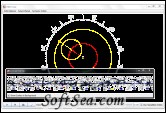|
Inferior Ptolemaic Model 
|
Ptolemy's orbit for a inferior planet simulation to help you with your studies. This simulation illustrates Ptolemy's orbit for a inferior planet. The model consists of a deferent circle, centered on a point some distance from Earth (at the eccentric point). Attached to this deferent is the center of another circle, the epicycle. The center of the epicycle moves around the deferent with constant angular speed as seen from the equant point, which is exactly opposite the center of the deferent from Earth (so the center of the epicycle does not move at constant speed along the defernet). The planet moves along the epicycle at constant speed. This model is capable of reproducing retrograde motion and variations in the planet's brightness. It can also reproduce variations in the apparent size and spacing of the retrograde arcs. In this simulation the planet is assumed to move in the plane of the ecliptic, so its latitude is always zero.
This model also shows the orbit of Sun around Earth. This illustrates the fact that the line from the equant point to the center of the epicycle is always parallel to the line from Earth to Sun.
The parameters are initially set to model the orbit of Venus. The user can select orbits for Venus, Mercury, or a user-defined orbit. Parameters for Venus and Mercury orbits are taken from Ptolemy's Almagest, but Ptolemy uses a moving deferent for Mercury which is not used in this simulation. The simulation can also display simplified orbits that do not use the eccentric and equant.
In addition, users can choose to display simplified Tychonic orbits of all five visible planets. Tycho Brahe used the same basic structure for all the planets that Ptolemy used for the inferior planets, with the main difference being that in the Tychonic system the deferent of each planet is just the orbit of Sun.
The top window shows the elements of the model. The bottom window shows the view from Earth.
Orbit Frame
1. Orbit Options Menu
* Show Zodiac in Background: show the signs of the zodiac around the orbit.
* Show Trace of Planet's Orbit: show a line tracing the planet's path.
* Show Sky View: show the view of an observer on Earth.
* Show Lines: show lines connecting important points.
* Show Center Points of Circles: show points at center of Sun's orbit, eccentric point, and equant point.
* Show Equant Circle: show circle centered on equant point and same size as deferent (to illustrate how motion appears uniform from equant).
* Show Deferent: show the deferent of the planet's orbit.
* Show Epicycle: show the epicycle of the planet's orbit.
* Show Sun's Orbit: show Sun's circular orbit.
2. Select Planet Menu: select Ptolemaic orbits for Mercury, Venus, or a user-defined orbit.
3. Tychonic Orbits Menu: select Tychonic orbits for Mercury, Venus, Mars, Jupiter, or Saturn. Note that for Tychonic orbits only the simplfied orbits (with no eccentric/equant) are shown.
4. Controls
* Play/pause: play or pause the simulation.
* Step: advance the simulation by one time step.
* Reset: reset the simulations to its initial state.
* Erase Trace: clear the trace of the planet's orbit.
* Time Step: the size of the time step used in the simulation. Increase this value to make the simulation run faster, reduce it to make the simulation run slower.
* Use Simplified Orbits: use orbits with no eccentric/equant.
5. Visual Elements
* Blue disk: Earth.
* Yellow/red disk: the inferior (yellow), or Tychonic superior (red), planet.
* Green circle: the deferent of the planet's orbit.
* Magenta circle: the epicycle of the planet's orbit.
* Green point: the eccentric point, which is the center of the deferent.
* Cyan circle: the equant circle. A radius of this circle drawn through the planet will rotate uniformly.
* Cyan point: the equant point. The center of the epicycle moves at a constant angular speed as seen from this point.
* Various lines connected the elements listed above.
* Yellow/red trace: trace of the planet's path.
* Zodiac symbols: symbols show the locations of the zodiacal constellations as seen from Earth.
Sky View Window
1. Visual Elements
* Yellow/red disk: the inferior (yellow), or Tychonic superior (red), planet.
* Orange disk: the sun.
* Background showing zodiacal constellations and symbols.
2. Show Zodiac in Background: checkbox to show zodiac constellations and symbols in background. The alternative is a black background.
Orbit Parameters (for User Defined orbit)
* Deferent Radius: distance from Earth to center of epicycle in astronomical units (AU). The distance from Earth to the sun is 1 AU.
* Deferent Angular Speed: the angular speed with which the center of the epicycle moves as seen from the equant point.
* Epicycle Radius: distance from the center of the epicycle to the planet (in AU).
* Epicycle Angular Speed: the angular speed with which the planet moves around the epicycle.
* Eccentricity: the distance from Earth to the center of the deferent (in AU).
* Longitude of Apogee: direction (in degrees east, or counterclockwise, from vernal equinox) toward the eccentric and equant points, as seen from Earth.
Requirements:
* Java
The license of this software is Freeware, you can free download and free use this graphing software.
